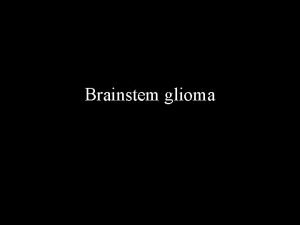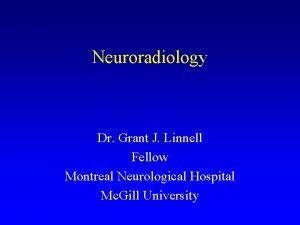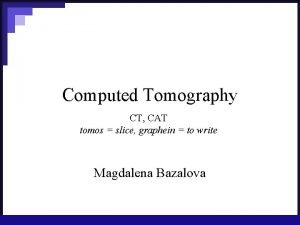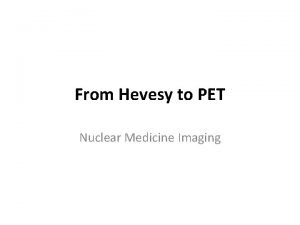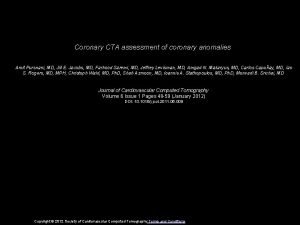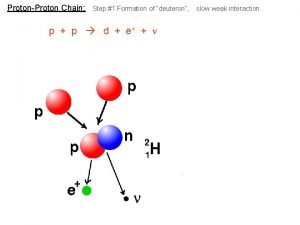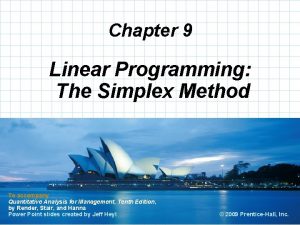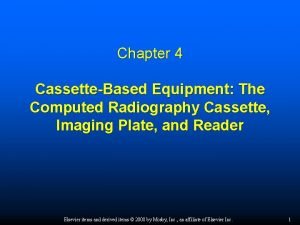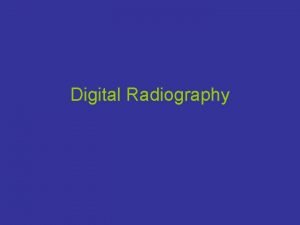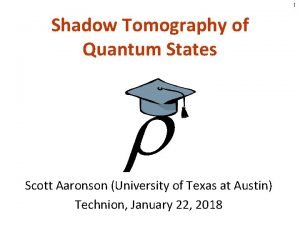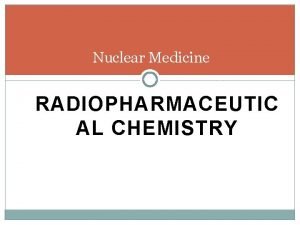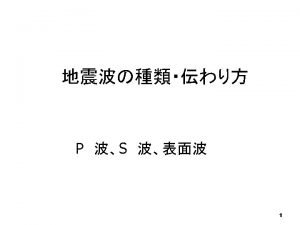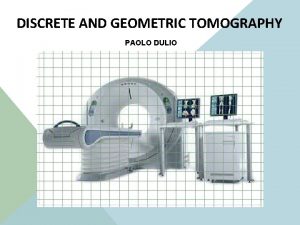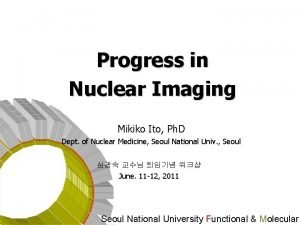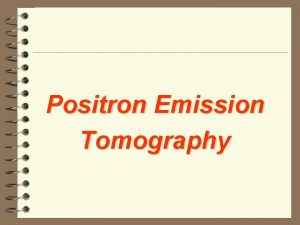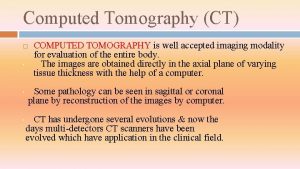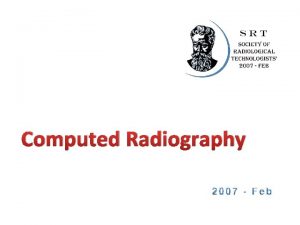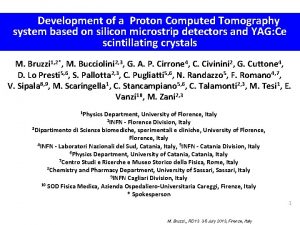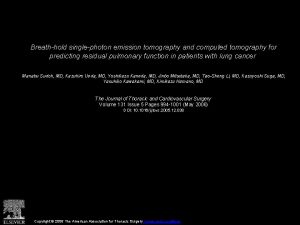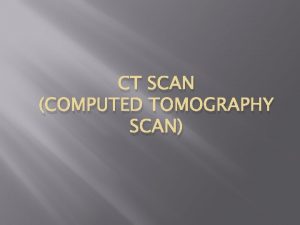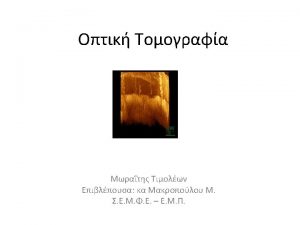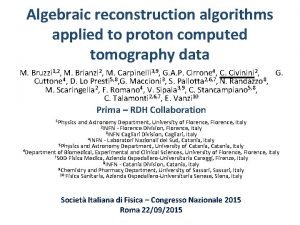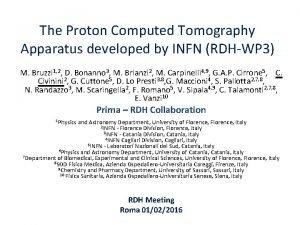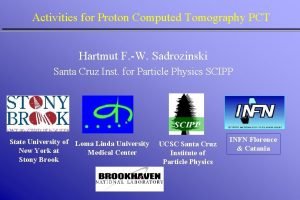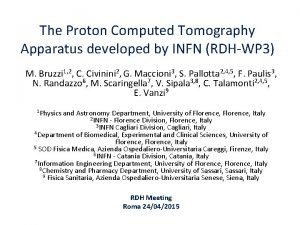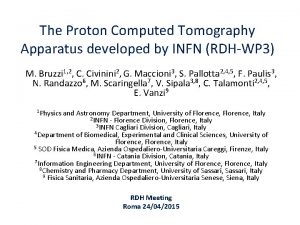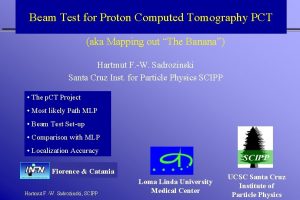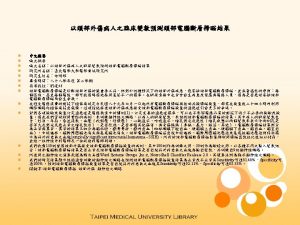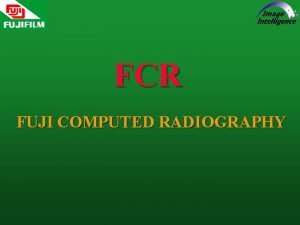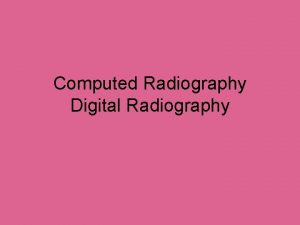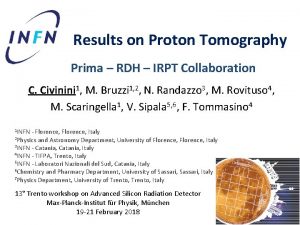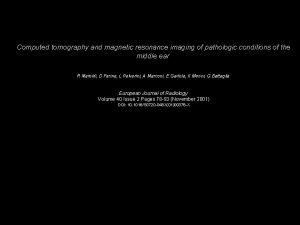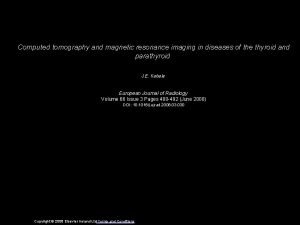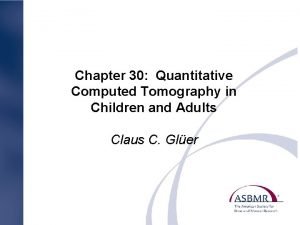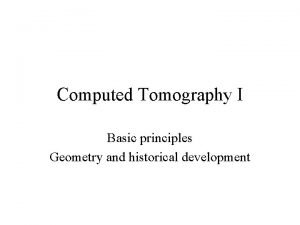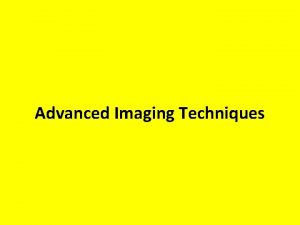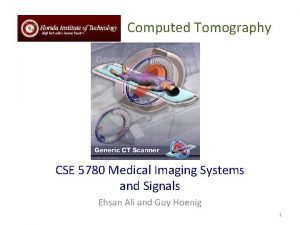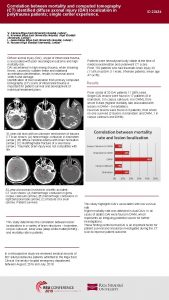Proton Computed Tomography system recent results and upgrade



























- Slides: 27

Proton Computed Tomography system: recent results and upgrade status M. Bruzzi 1, 2*, M. Bucciolini 2, 3, G. A. P. Cirrone 4, C. Civinini 2, G. Cuttone 4, D. Lo Presti 5, 6, S. Pallotta 2, 3, C. Pugliatti 5, 6, N. Randazzo 5, F. Romano 4, 7, V. Sipala 8, 9, M. Scaringella 1, C. Stancampiano 5, 6, C. Talamonti 2, 3, M. Tesi 1, E. Vanzi 10, M. Zani 2, 3 1 Physics Department, University of Florence, Italy 2 INFN - Florence Division, Italy 3 Dipartimento di Scienze biomediche, sperimentali e cliniche, University of Florence, Italy 4 INFN - Laboratori Nazionali del Sud, Catania, Italy, 5 INFN - Catania Division, Italy 6 Physics Department, University of Catania, Italy 7 Centro Studi e Ricerche e Museo Storico della Fisica, Rome, Italy 8 Chemistry and Pharmacy Department, University of Sassari, Italy 9 INFN Cagliari Division, Italy 10 SOD Fisica Medica, Azienda Ospedaliero-Universitaria Careggi, Firenze, Italy * Spokesperson 1 M. Bruzzi, , International Nuclear Physics Conference INPC 2013: 2 -7 June 2013, Firenze, Italy

Outline q Introduction: proton therapy and proton imaging q Proton imaging apparatus n Tracker Ø Ø Ø Single module architecture Detector VLSI front-end n Calorimeter Ø Ø Ø Crystal YAG: Ce Electronic readout Trigger system q First results with proton beam q Conclusions M. Bruzzi, , International Nuclear Physics Conference INPC 2013: 2 -7 June 2013, Firenze, Italy

Proton therapy The proton therapy is a good clinical treatment for cancer as it permits to obtain a dose distribution extremely conform to the target volume. The Bragg peak shape ensures that healthy tissues in front of and beyond the tumor are not damaged. Through the weighted superposition of proton beams of different energies it is possible to deposit a homogenous dose in the target region using only a single proton beam direction. (Spread Out Bragg Peak -SOBP). M. Bruzzi, , International Nuclear Physics Conference INPC 2013: 2 -7 June 2013, Firenze, Italy

proton Computed Tomography: why? In proton therapy treatments is important to know: Patient positioning: Currently performed using X-rays radiography in previous phase p. CT allows better accuracy and single phase positioning / treatments Dose Calculation: Currently performed using X-rays computed tomography Problem: protons and photons have different interaction with matter p. CT uses protons directly for dose calculation The error intrinsic in this conversion (due to e, Z) dependency on atomic number and electron density) is the principal cause of proton range indetermination (3%, up to 10 mm in the head) [Schneider U. (1994), Med Phys. 22, 353]

Parameters of p. CT Problem: protons, because the multiple Coulomb scattering, don’t move in straight line. M. Bruzzi, , International Nuclear Physics Conference INPC 2013: 2 -7 June 2013, Firenze, Italy

THE “PRoton IMAging (PRIMA) PROJECT” p. CR apparatus oriented to p. CT PROGRAM - Design and manufacture a high-performance prototype for proton radiography and tomography. - Develop suitable imaging algorithms; - Validate the p. CR/p. CT system with pre-clinical studies - Conceive an upgraded prototype for pre. clinical studies - Hardware and data acquisition; - Reconstruction algorithms. M. Bruzzi, , International Nuclear Physics Conference INPC 2013: 2 -7 June 2013, Firenze, Italy

Concept y x z P 1 P 2 P 3 P 4 proton Computed Radiography and Tomography Ø Ø Reveal the track of the single proton using a silicon telescope Measure the residual energy of the proton using a calorimeter Reconstruct the most likely path of the single proton p. CR for different projections with a rotating gantry Ø Single event information can be processed by reconstruction algorithms to produce tomographic images. M. Bruzzi, , International Nuclear Physics Conference INPC 2013: 2 -7 June 2013, Firenze, Italy

Architecture of the p. CT apparatus M. Bruzzi, , International Nuclear Physics Conference INPC 2013: 2 -7 June 2013, Firenze, Italy

Tracker module architecture • To achieve a read-out rate of 1 MHz a fully parallel digital strip readout system has been developed • Eight 32 -channel VLSI front-end chips acquire the detector signals and sends data in parallel to an FPGA (Xlinx Spartan-3 AN) which performs zero suppression and moves data to a buffer memory (~5 x 105 events). • An Ethernet commercial module is use both for data transfer to the central acquisition PC and to control the tracker module DAQ parameters M. Bruzzi, , International Nuclear Physics Conference INPC 2013: 2 -7 June 2013, Firenze, Italy

Silicon strip detector Manufactured by Hamamatsu Photonics 53 x 53 mm 2 p+-on-n strips 256 ch, 200 m pitch 200 m thickness (To reduce the multiple scattering in the detector while keeping a good sensitivity to protons) Vfd = 65 -75 V M. Bruzzi, , International Nuclear Physics Conference INPC 2013: 2 -7 June 2013, Firenze, Italy

VLSI front-end description • AMS 0. 35 u CMOS Technology • 1. 6 mm x 6 mm • 32 channels • Power dissipation = 14, 5 m. W @ chan • Vcc = +3. 3 V M. Bruzzi, , International Nuclear Physics Conference INPC 2013: 2 -7 June 2013, Firenze, Italy

Calorimeter • 4 YAG: Ce scintillating crystals Each crystal 30 x 30 mm 2 x 100 mm • 4 Photodiode 18 mm x 18 mm • 4 commercial front-end (Charge Sensitive Amplifier & shaper ) YAG: Ce properties PHYSICAL PROPERTIES Density [g/cm 3] 4. 57 Hygroscopic No Chemical formula Y 3 Al 5 O 12 LUMINESCENCE PROPERTIES Wavelength of max. emission [nm] 550 Decay constant [ns] 70 Photon yield at 300 k [103 Ph/Me. V] 40 -50 M. Bruzzi, , International Nuclear Physics Conference INPC 2013: 2 -7 June 2013, Firenze, Italy

p. CT system designed and manufactured by the PRIMA INFN CSN 5 collaboration 4 x-y TRACKER MODULES 1 CALORIMETER Entry and Exit position and direction Residual Energy M. Bruzzi, , International Nuclear Physics Conference INPC 2013: 2 -7 June 2013, Firenze, Italy

First tests: one x-y plane with YAG: Ce calorimeter (I) INFN LNS p 60 Me. V GOAL: to test the functionality of the architecture. A x-y tracker plane has been coupled with the calorimeter. The test has been performed at LNS with 60 Me. V proton beam. Collimator was used ( Ø 5 mm ). Rate 1 -50 k. Hz Counting map ( 1 crystal not connected) Data projection M. Bruzzi, , International Nuclear Physics Conference INPC 2013: 2 -7 June 2013, Firenze, Italy

First tests: one x-y plane with YAG: Ce calorimeter (II) INFN LNS p 60 Me. V Correlation between tracker and calorimeter data collimator removed from the beam pipe Map of events triggered by crystals II (red) and IV (black) Data projection Good correlation ! M. Bruzzi, , International Nuclear Physics Conference INPC 2013: 2 -7 June 2013, Firenze, Italy

First tests: Complete apparatus INFN LNS p 60 Me. V -Alignment test Tracker: 4 x-y planes -Radiography of a non homogeneous phantom -radiographies at different angles for first tomographic reconstruction Beam Calorimeter M. Bruzzi, , International Nuclear Physics Conference INPC 2013: 2 -7 June 2013, Firenze, Italy

First tests: Radiography of a walnut INFN LNS p 60 Me. V M. Bruzzi, , International Nuclear Physics Conference INPC 2013: 2 -7 June 2013, Firenze, Italy

First radiography tests with complete apparatus INFN LNS p 60 Me. V y P 1 P 2 P 3 P 4 Residual energy (Me. V) x • One cluster in each plane • Cut on difference between “entrance“ and “exit” angles Sigma=0. 170 ± 0. 09 mm FWHM = 0. 400± 0. 212 mm 18 Italy M. Bruzzi, , International Nuclear Physics Conference INPC 2013: 2 -7 June 2013, Firenze,

First radiography tests with complete apparatus Svedberg Laboratory Uppsala p 180 Me. V Pmma cylindrical phantom with holes 14 cm total thickness Not to scale Hole thickn. (cm) 1 1, 5 2, 3 3, 3 4, 5 6 8 10 • p. CT prototype mounted on 180 Me. V protons beam line • Radiography without filtering 19 M. Bruzzi, , International Nuclear Physics Conference INPC 2013: 2 -7 June 2013, Firenze, Italy

First Tomography tests with complete apparatus INFN LNS p 60 Me. V 2 cm PMMA phantom: diameter 2 cm, height 4 cm – holes f 4&6 mm, length 2 cm 36 projections (10 degrees steps) M. Bruzzi, , International Nuclear Physics Conference INPC 2013: 2 -7 June 2013, Firenze, Italy

Data Analysis: Tomographic equation • Definition of the tomographic equation (Wang, Med. Phys. 37(8), 2010: 4138) «projection» Unknown stopping power distribution (at E 0) • Evaluation of the “projection” term (through numerical integration starting from NIST tables and using the measured Eres) Eres Mean measured residual energy plotted at P 3 plane Wang projection Corresponding Wang projections Vanzi E. et al. The PRIMA collaboration: preliminary results in FBP reconstruction of p. CT data, in press on Nucl. Instrum. Meth A. M. Bruzzi, , International Nuclear Physics Conference INPC 2013: 2 -7 June 2013, Firenze, Italy

Data Analysis: Rebinning We defined a plane parallel to detector’s planes passing through the phantom axis. Plane is sampled in a 256 x 256 matrix, 200µm pixel size. For each event, associated projection bin is determined by the intersection of the line connecting P 2 and P 3 impact points with the plane. P 2 P 3

Tomographic reconstruction: first results Butterworth filter: order 2, cut-off 20/128 of the Nyquist freq. Good quality images without cuts: possibility of reducing acquisition times and dose in patient procedures Vanzi E. et al. The PRIMA collaboration: preliminary results in FBP reconstruction of p. CT data, in press on Nucl. Instrum. Meth A. M. Bruzzi, , International Nuclear Physics Conference INPC 2013: 2 -7 June 2013, Firenze, Italy

Resolution Evaluation The edge of the phantom is fitted with an erf function on 20 slices in the homogeneous region. The derivative of the erf function is a Gaussian function that describes the Line Spread Function (LSF) of the imaging system. FWHM=0. 9± 0. 1 mm Noise=2. 4% The mean FWHM of the LSF over the 20 slices was evaluated and used to quantify resolution. Mara Bruzzi Riunione RDH 22 Aprile 2013 Roma

Upgrade: the pre-clinical prototype A new prototype based on the same technology, to meet pre-clinical demands now under development • Increase 4 x of the active area • On-line data acquisition • Data rate up to 1 MHz Rectangular shape to perform tomography in slices Tracker: 4 x 1 silicon detectors 5 x 20 cm 2 active area Calorimeter: 7 x 2 YAG crystals 6 x 21 cm 2 active area top X 4 FE X 2 FE X 1 FE Scaringella M. et al. The PRIMA collaboration: , in press on Nucl. Instrum. Meth A. X 3 FE 25 M. Bruzzi, , International Nuclear Physics Conference INPC 2013: 2 -7 June 2013, Firenze, Italy

Upgrade: the upgraded calorimeter 7 x 2 YAG: Ce scintillating crystals 30 x 30 mm 2 x 100 mm each. Photodiodes assembled. Now under test (RDH) 26 M. Bruzzi, , International Nuclear Physics Conference INPC 2013: 2 -7 June 2013, Firenze, Italy

Conclusions • A p. CT apparatus has been designed and built by the PRIMA Collaboration INFN CSN 5 based on: – Silicon microstrip detectors 5 x 5 cm 2 active area – YAG: Ce cristal calorimeter • The prototype has been tested under proton beams with energies up to 180 Me. V with promising results. • First tomographic images were reconstructed with FBP with encouraging results. Even using the information on two planes only and without cuts on events good quality images were obtained. • A new prototype with larger area (5 x 20 cm 2) is under development for preclinical validation. • Future progress in WP 3 RDH Project INFN CSN 5. 27 M. Bruzzi, , International Nuclear Physics Conference INPC 2013: 2 -7 June 2013, Firenze, Italy
 Computed tomography
Computed tomography Radiology timisoara
Radiology timisoara Computed tomography artifacts
Computed tomography artifacts Ring artefact
Ring artefact George charles de hevesy
George charles de hevesy Dr amit pursnani
Dr amit pursnani Data acquisition system in ct scan
Data acquisition system in ct scan Proton proton chain
Proton proton chain Nuclear fission
Nuclear fission Proton proton chain
Proton proton chain A friend emails you the results
A friend emails you the results The zj row in a simplex table for maximization represents
The zj row in a simplex table for maximization represents Variable cost per unit example
Variable cost per unit example Cr cassette construction
Cr cassette construction Tracking signal definition
Tracking signal definition A computed is a calculation that a dbms performs
A computed is a calculation that a dbms performs What is computed radiography
What is computed radiography Shadow tomography of quantum states
Shadow tomography of quantum states Seismic tomography ______.
Seismic tomography ______. Positron emission tomography
Positron emission tomography Positron emission tomography
Positron emission tomography Seismic tomography
Seismic tomography Tomography
Tomography Positron emission tomography
Positron emission tomography Positron emission tomography
Positron emission tomography What is tomography
What is tomography Gate set tomography
Gate set tomography Upgrade 2003 to 2008
Upgrade 2003 to 2008
